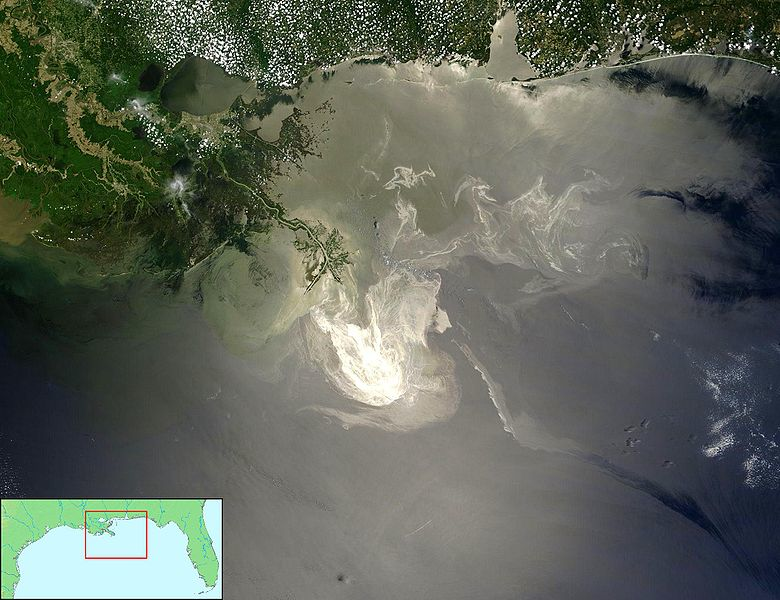Deepwater Horizon Oil Spill

Eric Hare
ggplot2
NOAA Data:
US Fisheries and Wildlife Data:
Both data sets have geographic coordinates for ever observation
NOAA data is a .rdata file so we need to read it specially:
getwd() command to find your current working directorylibrary(ggplot2)
library(maps)
load("noaa.rdata")Lets take a peek at the top of the floats NOAA data.
head(floats, n = 2)[,1:5]## callSign Date_Time JulianDay Time_QC Latitude
## 1 Q4901043 7/12/2010 2455390 1 24.823
## 2 Q4901043 7/12/2010 2455390 1 24.823head(floats, n = 2)[,6:10]## Longitude Position_QC Depth Depth_QC Temperature
## 1 -87.964 1 2 1 29.83
## 2 -87.964 1 4 1 29.65head(floats, n = 2)[,11:14]## Temperature_QC Salinity Salinity_QC Type
## 1 1 36.59 1 Float
## 2 1 36.58 1 Floatqplot(Longitude, Latitude, colour = callSign, data = floats) +
coord_map()
qplot(Longitude, Latitude, colour = callSign, data = gliders) +
coord_map()
qplot(Longitude, Latitude, colour = callSign, data = boats) +
coord_map()
This data has the same context - a common time and common place
ggplot2 we will superimpose data onto this grid in layersTo give you an idea…
states <- map_data("state")
ggplot() +
geom_path(data = states, aes(x = long, y = lat, group = group)) +
geom_point(data = floats, aes(x = Longitude, y = Latitude, colour = callSign)) +
geom_point(aes(x, y), shape = "x", size = 5, data = rig) +
geom_text(aes(x, y), label = "BP Oil Rig",
size = 5, data = rig, hjust = -0.1) +
xlim(c(-91, -80)) + ylim(c(22,32)) + coord_map()
| aesthetic | mapping |
|---|---|
| x | Longitude |
| y | Latitude |
| color | CallSign |
| aesthetic | scale |
|---|---|
| x | continuous |
| y | continuous |
| color | discrete |
Facetting: None
qplot() vs ggplot()qplot() stands for “quickplot”:
ggplot() stands for “grammar of graphics plot”
qplot() and ggplot() for FloatsTwo ways to construct the same plot for float locations:
qplot(Longitude, Latitude, colour = callSign, data = floats) Or:
ggplot(data = floats,
aes(x = Longitude, y = Latitude, colour = callSign)) +
geom_point() +
scale_x_continuous() +
scale_y_continuous() +
scale_colour_discrete()We fortunately don’t need to be so verbose - Even ggplot() will automatically pick default scales:
ggplot(data = floats,
aes(x = Longitude, y = Latitude, colour = callSign)) +
geom_point()
A layer added ggplot() can be a geom…
… or a position adjustment to the scales
| Plot | Geom | Stat |
|---|---|---|
| Scatterplot | point | identity |
| Histogram | bar | bin count |
| Smoother | line + ribbon | smoother function |
| Binned Scatterplot | rectangle + color | 2d bin count |
More geoms described at http://docs.ggplot2.org/current/
Want to build a map using NOAA data
ggplot() +
geom_path(data = states, aes(x = long, y = lat, group = group)) +
geom_point(data = floats, aes(x = Longitude, y = Latitude, colour = callSign)) +
geom_point(aes(x, y), shape = "x", size = 5, data = rig) +
geom_text(aes(x, y), label = "BP Oil Rig", size = 5, data = rig, hjust = -0.1) +
xlim(c(-91, -80)) +
ylim(c(22, 32)) + coord_map()

animal <- read.csv("http://heike.github.io/rwrks/02-r-graphics/data/animal.csv")